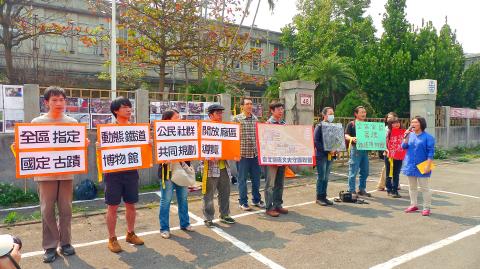The Ministry of Culture yesterday announced its decision to designate the Taipei Railway Workshop as a national cultural heritage site, marking a long-awaited victory for cultural preservation groups.
The decision signaled an abrupt halt to earlier development plans proposed by former Taipei mayor Hau Lung-bin’s (郝龍斌) administration, which originally allocated 57 percent of the 17-hectare site for commercial use.
Cultural Heritage Bureau director-general Shy Gwo-lung (施國隆) yesterday said that the compound would be preserved in its entirety, while the historic workshop itself would be renovated to house a railway museum.

Photo: Yu Pei-ju, Taipei Times
Constructed in the 1930s during Japanese colonial rule, the Taipei Railway Workshop was known as the “hospital” for the nation’s trains, and considered the most important railway maintenance depot in Taiwan.
The compound features a diverse range of architecture, including an engine room and a Japanese-style bath house, as well as lush vegetation.
Announced in September last year, original plans for the site provoked a prolonged campaign spearheaded by cultural preservation groups and railway enthusiasts, who said that the compound should be preserved in its entirety to preserve knowledge of the maintenance process.
Although several buildings within the compound were designated as historical monuments through successive campaigns in 2000, 2012 and 2013, the compound as a whole lacked adequate protection, the activists said.
“The importance of the Taipei Railway Workshop lies not only in its architecture, but also in its role as an assembly line for industrial production and its role within the context of an industrial landscape,” activist Huang Li-ping (黃立品) said.
Proposed commercial uses for the compound also stoked anger among nearby residents, who said that local infrastructure would be inadequate to accommodate a massive influx of tourists and shoppers to the area following the construction of the Songshan Cultural Park and the Farglory Dome project nearby.
Earlier yesterday morning, members of the Taipei Railway Workshop Heritage Conservation Union congregated outside the site, demanding that authorities help to protect the compound and increase public participation in future plans.
In a symbolic gesture to offer their blessing to the beleaguered site, dozens of activists and their supporters tied yellow ribbons to the fences that surround the compound.
Meanwhile, the Taiwan Railways Administration (TRA), which would prefer to develop the site to fulfill its needs, was not happy about the decision.
TRA Deputy Director-General Chung Ching-da (鐘清達) said that the Cultural Heritage Preservation Act (文化資產保存法) holds the owner of the property responsible for managing and maintaining a historical site, adding that the managing and maintenance of a historical site was not the railway operator’s forte.
Nor did the administration have the manpower and funding to preserve the historical site, he said.
“They only know how to give birth to the child, but they are not raising it themselves,” he said of the activists, adding that different agencies should share the burden of preserving the historical site in a more reasonable and responsible manner.
Additional reporting by CNA

Taiwan is to commence mass production of the Tien Kung (天弓, “Sky Bow”) III, IV and V missiles by the second quarter of this year if the legislature approves the government’s NT$1.25 trillion (US$39.78 billion) special defense budget, an official said yesterday. Commenting on condition of anonymity, a defense official with knowledge of the matter said that the advanced systems are expected to provide crucial capabilities against ballistic and cruise missiles for the proposed “T-Dome,” an advanced, multi-layered air defense network. The Tien Kung III is an air defense missile with a maximum interception altitude of 35km. The Tien Kung IV and V

The disruption of 941 flights in and out of Taiwan due to China’s large-scale military exercises was no accident, but rather the result of a “quasi-blockade” used to simulate creating the air and sea routes needed for an amphibious landing, a military expert said. The disruptions occurred on Tuesday and lasted about 10 hours as China conducted live-fire drills in the Taiwan Strait. The Civil Aviation Administration (CAA) said the exercises affected 857 international flights and 84 domestic flights, affecting more than 100,000 travelers. Su Tzu-yun (蘇紫雲), a research fellow at the government-sponsored Institute for National Defense and Security Research, said the air

A strong continental cold air mass is to bring pollutants to Taiwan from tomorrow, the Ministry of Environment said today, as it issued an “orange” air quality alert for most of the country. All of Taiwan except for Hualien and Taitung counties is to be under an “orange” air quality alert tomorrow, indicating air quality that is unhealthy for sensitive groups. In China, areas from Shandong to Shanghai have been enveloped in haze since Saturday, the ministry said in a news release. Yesterday, hourly concentrations of PM2.5 in these areas ranged from 65 to 160 micrograms per cubic meter (mg/m³), and pollutants were

Taiwan’s armed forces have established response protocols for a wide range of sudden contingencies, including the “Wan Chun Plan” to protect the head of state, the Ministry of Defense (MND) said today. After US President Donald Trump on Saturday launched a series of airstrikes in Venezuela and kidnapped Venezuelan President Nicolas Maduro, concerns have been raised as to whether China would launch a similar “decapitation strike” on Taiwan. The armed forces regularly coordinate with relevant agencies and practice drills to ensure preparedness for a wide range of scenarios, Vice Minister of National Defense Hsu Szu-chien (徐斯儉) told reporters before a